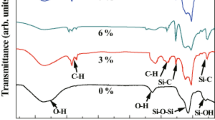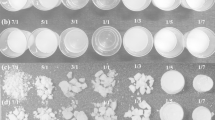Abstract
The experimental results on the hydrophobic and physical properties of tetraethoxysilane (TEOS) based silica aerogels by incorporating phenyltriethoxysilane (PTES) as a synthesis component, are reported. The molar ratio of tetraethoxysilane (TEOS), ethanol (EtOH), water (0.001 M oxalic acid catalyst) was kept constant at 1:5:7 respectively while the molar ratio of PTES/TEOS (M) was varied from 0 to 0.7. After gelation, the alcogels were dried supercritically by the high temperature solvent extraction. For lower M values (<0.1), transparent and monolithic aerogels but for higher M values (>0.5) opaque and cracked aerogels were obtained. For M values in between 0.1 and 0.5, monolithic aerogels with decreasing optical transmission have been obtained. The hydrophobicity of the aerogels was tested by measuring the percentage of water uptake by the aerogels when exposed to 95% humidity at 40°C for 24 h and also by measuring the contact angle. The contact angle varied from 120 to 130° for M values from 0.1 to 0.5, respectively. It was found that as the M value increased, the hydrophobicity of the aerogels increased but the optical transmission decreased from 60% to 5% in the visible range. The thermal conductivity and the specific heat of the aerogels found to decrease with the increase in M values. In order to determine the thermal stability in terms of retention of hydrophobicity of the aerogels, they were heat treated in air in the temperature range of 25–600°C. The hydrophobic aerogels are thermally stable upto a temperature of 520°C, which is the highest value ever reported, and above this temperature the aerogels become hydrophilic. The chemical bonds, responsible for the hydrophobic nature of the aerogels, have been identified by Fourier transform infrared spectroscopy (FTIR). The aerogels have been characterized by density, optical transmission, scanning electron microscopy (SEM), thermogravimetric analysis (TGA) and differential thermal analysis (DTA).
Similar content being viewed by others
References
L. W. Hrubesh, Chem. Ind. 17 (1990) 824.
J. Fricke and A. Emmerling, Struct. Bonding 77 (1992) 27.
A. Venkateswara Rao, G. M. Pajonk and N. N. Parvathy, J. Sol-Gel. Sci. Technol. 3 (1994) 205.
M. Schmidt and F. Schwertfeger, J. Non-Cryst. Solids 225 (1998) 364.
G. M. Pajonk, ibid. 225 (1998) 307.
A. J. Hunt and K. D. Lofftus, Adv. Sol. Energy. Technol. 4 (1998) 3146.
L. W. Hrubesh, J. Non-Cryst. Solids 225 (1998) 335.
J. Fricke and T. Tillotson, Thin Solid Films 297 (1997) 212.
N. Husing and U. Schubert, Angew. Chem. Int. Ed. 37 (1998) 22.
A. Venkateswara Rao, G. M. Pajonk and N. N. Parvathy, J. Mater. Sci. 29 (1994) 1807.
A. R. Buzykaev, A. F. Danilyuk, S. F. Ganzhur, E. A. Kravchenko and A. P. Onuchin, Nucl. Instrum. Methods Phys. Res. A 433 (1999) 396.
H. P. Meissner, A. S. Michaels and R. Kaiser, Ind. Eng. Chem. Proc. Des. Div. 3 (1964) 202.
J. J. Bikerman, “Surface Chemistry: Theory and Applications,” 2nd ed. (Academic Press, New York, 1958) p. 343.
F. Schwertfeger, A. Emmerling, J. Gross, U. Schubert and J. Fricke in “Sol-Gel Processing and Applications,” edited by Y. A. Attia (Plenum Publishing Company, New York, 1994) p. 343.
H. Yokagawa and M. Yokoyama, J. Non. Cryst. Solids. 186 (1995) 23.
F. Schwertfeger, D. Frank and M. Schmidt, J. Non-Cryst. Solids 225 (1998) 24.
A. Venkateswara Rao and G. M. Pajonk, J. NonCryst. Solids 285 (2001) 202.
Eugene Hecht, “Physics” (Brooks/cole Publishing Company, Wadsworth, Inc., Belmont, California, 1994) p. 519.
Ae-Young Jeong, Sang-Man Goo and Dang-Pyo Kim, J. Sol-Gel. Sci. Technol. 19 (2000) 483.
B. E. Yoldas, J. Non-Cryst. Solids 63 (1984) 145.
F. Schwertfeger, W. Glaubitt and V. Schubert, J. Non. Cryst. Solids 145 (1992) 85.
Author information
Authors and Affiliations
Corresponding author
Rights and permissions
About this article
Cite this article
Rao, A.V., Kalesh, R.R. & Pajonk, G.M. Hydrophobicity and physical properties of TEOS based silica aerogels using phenyltriethoxysilane as a synthesis component. Journal of Materials Science 38, 4407–4413 (2003). https://doi.org/10.1023/A:1026311905523
Issue Date:
DOI: https://doi.org/10.1023/A:1026311905523




